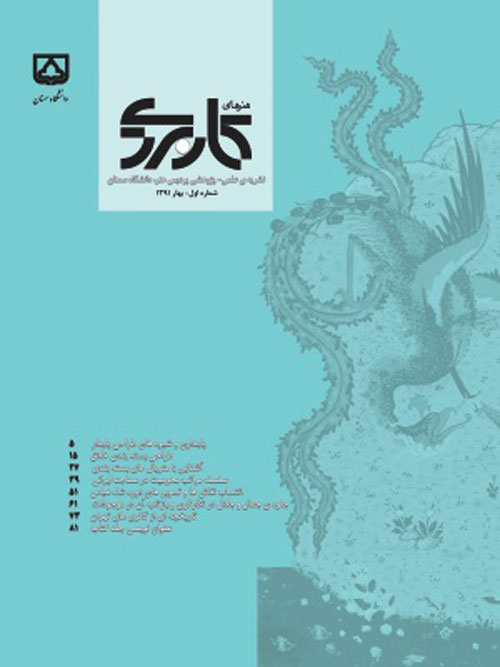Functional and Decorative Properties of Outdoor Fabric Curtains in the Qajar Buildings(Case Study: Gloestan Palace)
Author(s):
Abstract:
Using outdoor curtains has a very long history in Persian Architecture. Its necessity originated from Irans Warm and dry climate that obliged people to reduce their contact with harsh climate, especially sunshine during hot seasons to reduce inside temperature and reducing Air convection to keep inside temperature during cold seasons.
During Qajar era, we can see a special type of outdoor curtains that is made from fabrics with special elaborated embroideries that covered facades of private and public buildings. Especially the most beautiful type of them can be seen in Historical photos of Golestan palace. Through historical drawings of orientalist and Golestan photo Archive, we can see the changes of design and ornaments of this curtains. Present article tries to investigate the functional aspects of these Fabric Curtains, their shapes & ornaments and chronological changes of their ornamental styles. A Descriptive-Analytical method was used and article focuses on Palaces and governmental buildings of Tehran, Qajar capital city especially Golestan palace buildings during Nasser-al-din shah.
Result shows that the main reason of adding this curtains to buildings façade had been the changes of traditional patterns of Iranian architecture and depicting European architecture without attention to Persian climate that shaped this necessary accessory to reduce climatic problems of buildings. From climatic view, these outdoor curtains were used as a prevention from direct sunshine rays during hot seasons, a barrier to reduce air convection through wooden windows during cold seasons and nights and as a protector to preserve ornaments from showers. The most common designs are like Persian carpets consisting an ornamental border and central lozenge. Their ornaments have two aims. first, strengthens their structures from tearing and as part of their mechanical system and overall design tries to reshape building facades and depicted their architectural aspects in compose with ornamental and symbolic motifs.
During Qajar era, we can see a special type of outdoor curtains that is made from fabrics with special elaborated embroideries that covered facades of private and public buildings. Especially the most beautiful type of them can be seen in Historical photos of Golestan palace. Through historical drawings of orientalist and Golestan photo Archive, we can see the changes of design and ornaments of this curtains. Present article tries to investigate the functional aspects of these Fabric Curtains, their shapes & ornaments and chronological changes of their ornamental styles. A Descriptive-Analytical method was used and article focuses on Palaces and governmental buildings of Tehran, Qajar capital city especially Golestan palace buildings during Nasser-al-din shah.
Result shows that the main reason of adding this curtains to buildings façade had been the changes of traditional patterns of Iranian architecture and depicting European architecture without attention to Persian climate that shaped this necessary accessory to reduce climatic problems of buildings. From climatic view, these outdoor curtains were used as a prevention from direct sunshine rays during hot seasons, a barrier to reduce air convection through wooden windows during cold seasons and nights and as a protector to preserve ornaments from showers. The most common designs are like Persian carpets consisting an ornamental border and central lozenge. Their ornaments have two aims. first, strengthens their structures from tearing and as part of their mechanical system and overall design tries to reshape building facades and depicted their architectural aspects in compose with ornamental and symbolic motifs.
Keywords:
Language:
Persian
Published:
Applied Arts Journal, Volume:5 Issue: 1, 2016
Pages:
27 to 37
https://magiran.com/p1744142
دانلود و مطالعه متن این مقاله با یکی از روشهای زیر امکان پذیر است:
اشتراک شخصی
با عضویت و پرداخت آنلاین حق اشتراک یکساله به مبلغ 1,390,000ريال میتوانید 70 عنوان مطلب دانلود کنید!
اشتراک سازمانی
به کتابخانه دانشگاه یا محل کار خود پیشنهاد کنید تا اشتراک سازمانی این پایگاه را برای دسترسی نامحدود همه کاربران به متن مطالب تهیه نمایند!
توجه!
- حق عضویت دریافتی صرف حمایت از نشریات عضو و نگهداری، تکمیل و توسعه مگیران میشود.
- پرداخت حق اشتراک و دانلود مقالات اجازه بازنشر آن در سایر رسانههای چاپی و دیجیتال را به کاربر نمیدهد.
In order to view content subscription is required
Personal subscription
Subscribe magiran.com for 70 € euros via PayPal and download 70 articles during a year.
Organization subscription
Please contact us to subscribe your university or library for unlimited access!


